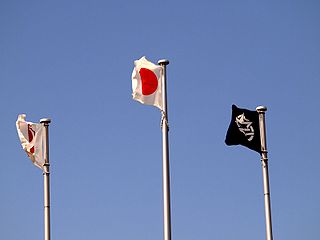The Nihon SF Taikai is an annual science fiction convention held in Japan. Each of these conventions is officially the Nth Nihon SF Taikai (第N回日本SF大会), but they are more popularly known by the official nicknames given to them based on their locations, e.g. TOKON or DAICON.

The transport network in Greater Tokyo includes public and private rail and highway networks; airports for international, domestic, and general aviation; buses; motorcycle delivery services, walking, bicycling, and commercial shipping. While the nexus is in the central part of Tokyo, every part of the Greater Tokyo Area has rail or road transport services. There are also a number of ports offering sea and air transport to the general public.
This page lists Japan-related articles with romanized titles beginning with the letter K. For names of people, please list by surname. Please also ignore particles when listing articles.
This page lists Japan-related articles with romanized titles beginning with the letter T. For names of people, please list by surname. Please also ignore articles when listing articles.

The list of Japanese municipal flags lists the flags of municipalities of Japan. Most municipalities of Japan have unique flags. Like prefectural flags, most of them are with a bicolor geometric highly stylized symbol (mon), often incorporating characters from Japanese writing system. However, there are three types of symbols. Therefore, the list will also discuss the emblems or logos.
Location View was an interactive website developed by Tokyo-based company LocationView Co. offering registered users a street-level view of selected cities in Japan. It featured 360-degree horizontal and 180-degree vertical panning, zoom, and virtual mobility in which the user could control speed. Unlike other street view services, such as MapJack or Google Maps’ Streetview, Location View had a high frame rate and seamless transition between frames, enabling continuous, lifelike motion and surroundings which were animated rather than static. The site was developed by the Location View Co. and introduced on 14 May 2007 in Japan. When it was launched, several major cities in Japan, such as Tokyo, Yokohama, Kawasaki, Nagoya, Kyoto, Osaka and Himeji were included. It was since expanded to include the suburbs of a number of other Japanese cities. The service was closed down on 27 April 2009.
Nishi-ku (西区) is a common ward name in many Japanese cities.
This page is based on this
Wikipedia article Text is available under the
CC BY-SA 4.0 license; additional terms may apply.
Images, videos and audio are available under their respective licenses.













